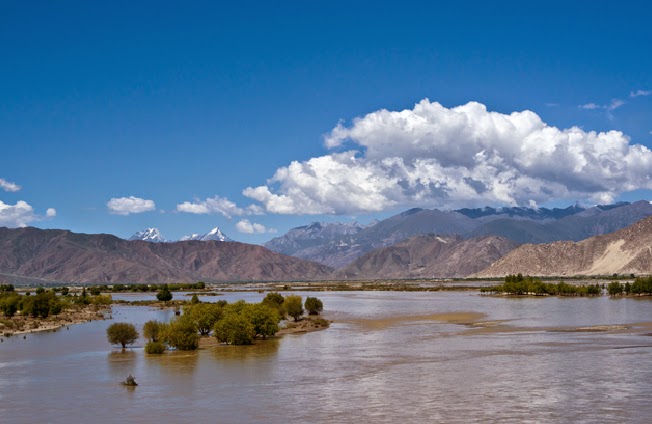
The Himalaya features some of the most impressive gorges on Earth that have been formed by rivers. The geologic history of the famous Tsangpo Gorge, in the eastern Himalaya, now needs to be rewritten.
A team of German, Chinese, and American geoscientists have namely discovered a canyon, filled with more than 500 m of sediments beneath the bed of the present-day Yarlung Tsangpo River upstream from the gorge. Using drill cores, the scientists were able to reconstruct the former valley floor of this river, which allowed them to reconstruct the geological history of the Tsangpo Gorge (Science, 21.11.2014). They discovered that the gorge obtained its steep form in response to rapid tectonic uplift in the Himalaya, two to three million years ago. “Because of its high gradient, the river incises its bed very rapidly”, explains Dirk Scherler from the GFZ German Research Centre for Geosciences. “The rocks here are eroded at annual rates of up to one centimeter per year which is matched by tectonic uplift of the same rate.” The collision of India with the Eurasian continent has created a tectonic dam here.
This barrier caused a lower flow velocity of the Yarlung Tsangpoupstream. Previously, the river had deeply incised into the Tibetan Plateau. Due to the reduced flow rate the sediments which the Yarlung Tsangpo River and its tributaries eroded from the highlands were deposited in the river bed along hundreds of kilometers.
The scientists estimated that these deposits are up to 1000 m thick. “Five drillings have been conducted over a distance of 300 km upstream of the gorge”, says Dirk Scherler. “One of the drillings encountered bedrock after 540 meters of sediments. From the drill cores, we were able to infer the reduction in stream flow velocity and date the initiation of sedimentation using cosmogenic nuclides. These are rare isotopes that are produced by cosmic rays near the Earth’s surface. Three Million years ago, the river was still incising into Himalayan bedrock.” But today the once huge canyon is buried by sediments.
The Yarlung Tsangpo is the largest high mountain river on Earth. It flows along a distance of 1700 km across the Tibetan Plateau, at an elevation of around 4000 meters and follows the boundary between India and Eurasia. In the eastern Himalaya, the river leaves the high plateau and breaks through the world famous, horseshoe-shaped Tsangpo Gorge for the plains of India.
The new findings show that rapid incision of the Yarlung Tsangpo and the development of the Tsangpo Gorge occurred in response to tectonic uplift, and not, as previously thought, the other way round. In addition, these observations refute existing hypotheses that relate the origin of the Tsangpo Gorge to river capture of the Yarlung Tsangpo by the Brahmaputra River.
Reference:
P. Wang, D. Scherler et al.: „Tectonic Control of Yarlung Tsangpo Gorge Revealed by a Buried Canyon in Southern Tibet”, Science Nr. 6212, Vol. 346, pp. 978-980, 21.11.2014, DOI: 10.1126/science.1259041
Note : The above story is based on materials provided by GFZ GeoForschungsZentrum Potsdam, Helmholtz Centre










